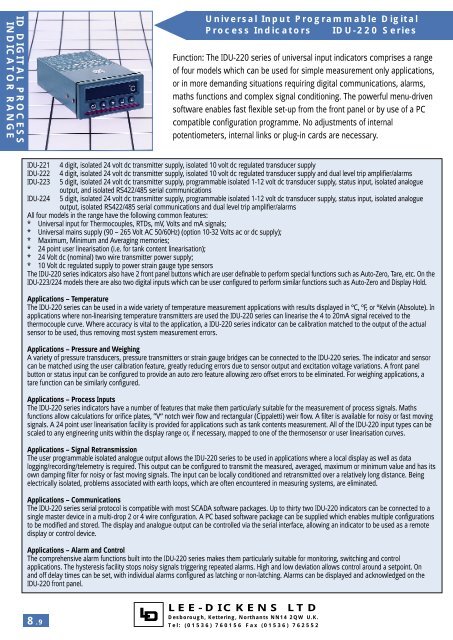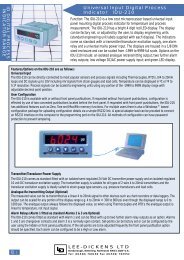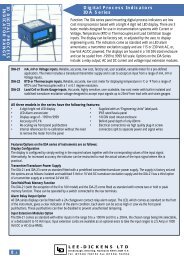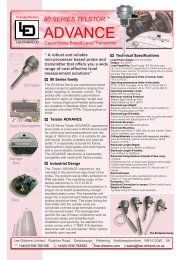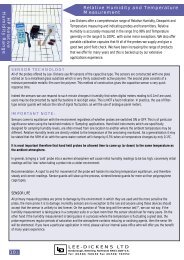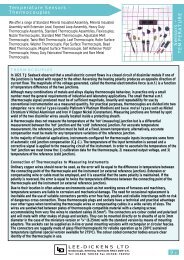ID DIGIT AL PROCESS INDICA TOR RANGE LEE-DICKENS LTD
ID DIGIT AL PROCESS INDICA TOR RANGE LEE-DICKENS LTD
ID DIGIT AL PROCESS INDICA TOR RANGE LEE-DICKENS LTD
- No tags were found...
Create successful ePaper yourself
Turn your PDF publications into a flip-book with our unique Google optimized e-Paper software.
Universal Input Programmable Digital Process Indicators<strong>ID</strong>U-220 Series(continued)Features – Universal InputAll of the <strong>ID</strong>U-220 series can be directly connected to most process sensors including thermocouples, RTDs, mA loops, transmitteroutputs, and other dc signals. All thermosensor ranges have built-in linearisation curves and internal or external CJC is available. Thedecimal point position can either be user-programmed to give the required display resolution or set to auto-ranging mode. The sensoropen circuit detection can be selected to produce upscale or downscale readings. Process inputs can be scaled to any engineeringunits and any input can be mapped to one of the thermosensor linearisation curves.Features – Sensor ExcitationAll <strong>ID</strong>U-220 series indicators are fitted with a fixed 24 Volt dc output which is electrically isolated. This can be used to power a single looppowered transmitter. In addition the <strong>ID</strong>U-221 and the <strong>ID</strong>U-222 have a 10 Volt dc regulated supply whilst the <strong>ID</strong>U-223 and the <strong>ID</strong>U-224 havea programmable 0 to 12 Volt dc regulated output. In all four instruments the output is electrically isolated to 500 Volts. The programmablesupply is configured via the internal software and is primarily designed to power strain gauge type sensors including load cells.<strong>ID</strong> <strong>DIGIT</strong><strong>AL</strong> <strong>PROCESS</strong><strong>INDICA</strong><strong>TOR</strong> <strong>RANGE</strong>Features – User LinearisationSome applications require a special linearisation curve to be defined by the user. A typical example is tank contents measurement where thepressure of a liquid can be measured but this does not have a linear relationship to the actual volume. The user linearisation function on the <strong>ID</strong>U-220series indicators allows up to 24 calibration points to be defined. Each point can be entered manually or, for greater accuracy, directly from thesensor output, thus removing most system measurement errors. The 24 points can be entered in any order.Features – Analogue OutputThe <strong>ID</strong>U-223 and <strong>ID</strong>U-224 are fitted with an electrically isolated analogue output which has 0.05% resolution. The output can be configured by theuser as a 0 to 20mA, 4 to 20mA or 0 to 10 Volt dc signal and can be scaled over any of the display range. For example, a type K thermocouple inputcan be retransmitted as a linear 4 to 20mA signal equivalent to 0 to 1000ºC to another device such as a chart recorder or a data logger. Theanalogue output can be set to transmit the measured, the maximum, the minimum or the averaged value and has its own damping filter for noisy orfast moving signals.Features – Serial CommunicationsThe <strong>ID</strong>U-223 and the <strong>ID</strong>U-224 are fitted with an electrically isolated RS422/485 serial interface. All measured values and set-up parameters areaccessible, however, the instruments can be set to be read only, thus protecting their configuration. Two protocols are available, namely, MODBUSand a proprietory manufacturers protocol, which has been designed to be easier to implement. The display, analogue output and transducer supplycan all be configured via the serial interface.Features – AlarmsEach of the <strong>ID</strong>U-220 series indicators has four software configurable alarm settings. These can be configured by the user for alarm type, setpoint,on/off delay and on/off hysteresis value. Alarms can be individually set to be latching or non-latching and to flash a message on the front paneldisplay when active. The <strong>ID</strong>U-222 and <strong>ID</strong>U-224 models are fitted with 2 relays which can be operated by any of the four alarm setpoints. In additiona special AND function allows the relays to switch only if two or more of the alarm conditions are active. Relays can be configured to be energisedor de-energised in the alarm condition.Features – Password ProtectionThe <strong>ID</strong>U-220 instrument‘s configuration can be protected by the use of a user-defineable password. In addition, editing of the alarm set-points,alarm acknowledging and the resetting of the maximum, minimum or average value memory can be individually protected from an operator.Features – Function ButtonsThe two buttons marked (@ and (*) on the front panel of all models can be user-programmed to give operator level access to one or more of thefollowing functions: Tare; Auto-Zero; Display Hold; Display Maximum; Display Minimum; Display Average; Reset Maximum, Minimum andAverage; Display Test.Features – SoftwareAll configuration parameters can be password protected and are preserved in the event of a power failure. The following software functions areavailable to the user:Input Type Maths Functions Models <strong>ID</strong>U-223 and 224 onlyLinearisation Type Alarm Set-up x 4 Status Input Set-up x 2Internal or External CJC Averaging Time Period Transducer Supply Set-upSensor Break Detection User Linearisation Analogue Output Set-upDisplay Resolution Password Set-up Analogue Output ScalingDisplay Filter Time Constant Function Button Set-up x 2 Analogue Output DampingScaling and Calibration Relay Set-up (222/224 only) Serial Communications Set-up<strong>LEE</strong>-<strong>DICKENS</strong> <strong>LTD</strong>Desborough, Kettering, Northants NN14 2QW U.K.Tel: (01536) 760156 Fax (01536) 7625528.10


